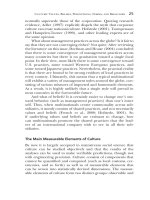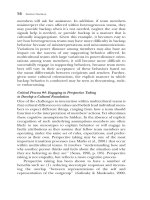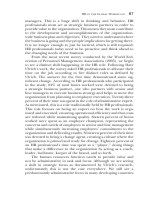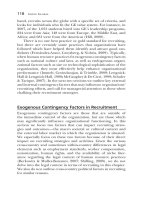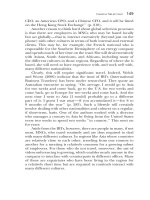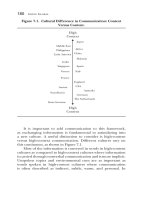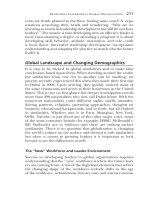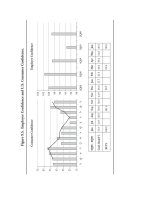Going Global Practical Applications and Recommendations for HR and OD Professionals in the Global Workplace_10 ppt
Bạn đang xem bản rút gọn của tài liệu. Xem và tải ngay bản đầy đủ của tài liệu tại đây (522.67 KB, 31 trang )
Best Practices for Training Intercultural Competence 273
and culture specific) result in better job performance when com-
pared to a control condition (Cushner, 1989; Mitchell & Foa,
1969; O’Brien, Fiedler, & Hewett, 1971; Worchel & Mitchell,
1972). Earley (1987) found that trainees given either area studies
or experiential training received higher job performance ratings
and reported less interpersonal adjustment difficulties compared
with trainees placed in the control condition. Finally, Sanchez-
Burkes and colleagues (2007) found that trainees given relational
ideology training reported higher perceived performance and
intercultural adjustment compared with trainees given cultural
assimilators. Though the number of studies examining the trans-
fer of intercultural competence training is small, results to date
seem to indicate that training interventions, such as cultural assim-
ilators, area studies, experiential training, and relational ideology
training, do have positive impacts on performance and adjustment
on the job.
Affective Learning Outcomes
Compared to studies examining skill-based outcomes, there have
been fewer empirical investigations regarding how intercultural
competence influences affective outcomes. Three notable studies
that have examined affective intercultural learning outcomes are
Bhawuk (1998), Bird and colleagues (1993), and Sorcher and
Spence (1982). In Bhawuk’s (1998) study, trainees who were
given the theory-based cultural assimilator showed more intention
to change behavior as measured by the intercultural sensitivity
inventory than trainees given either the culture-general, cultural-
specific, or control training interventions. Bird and colleagues
(1993) found that area studies had no effect on trainees’ attitudes
toward Japanese people, culture, management, products, and
art when compared with trainees placed in a control condition.
Sorcher and Spence (1982) assessed attitude change via self-
report and interviews and found that behavioral modeling training
resulted in no changes in attitudes compared with a control
condition when assessed by a self-report, but resulted in significant
changes in attitudes compared with a control condition when
assessed by an interview. This study, in particular, highlights the
importance of usinga multimethod approach to assessing learning
274 Going Global
outcomes. Taken together, these results suggest that intercultural
competence training can have an influence on trainee attitudes.
Summary
Cultural assimilators, whether in culture-specific, culture-general,
or theory-based form, clearly emerged as the most frequently
studied intercultural competence training intervention. Cultural
assimilators were found to increase rote knowledge, intercultural
adjustment, job performance, and intercultural sensitivity atti-
tudes. Area studies appear to be ideal for increasing trainee
knowledge of a culture. Behavioral modeling and relational
ideology training have also emerged as promising training inter-
ventions that have positive impacts on intercultural performance
and adjustment. Unfortunately, the limited body of research on
intercultural competence training effectiveness prevents making
any absolute statements regarding superiority, especially given the
mixed results found in field survey data. The first step toward
improving our understanding of intercultural competence train-
ing outcomes is to properly assess all training interventions that
are implemented in global organizations. In the next section, we
discuss the importance of training evaluation, and provide sev-
eral tools for assessing the outcomes of intercultural competence
training.
Intercultural Competence Assessment Tools
As the importance of intercultural competence training continues
to increase, so too will the importance of developing or identi-
fying methods to assess such programs. Sercu (2004) points out
that ‘‘employers desire a reliable assessment tool that can predict
whether a particular employee possesses the necessary knowledge,
skills, attitudes and personality traits to be successful in intercul-
tural (business) contacts’’ (p.73). There is a consensus among
researchers that the systematic evaluation of training programs
is critical to the success of such programs (Goldstein, 1993),
and this consensus extends to intercultural competence training
as well. Training evaluation generally comprises the collection
and interpretation of data regarding the utility of training pro-
grams (Goldstein, 1986). Training evaluation serves two primary
Best Practices for Training Intercultural Competence 275
purposes: it ensures that trainees meet learning objectives set
forth prior to training, and it diagnoses whether or not the train-
ing program as a whole was effective in improving performance
(Kraiger et al., 1993). Without such data it would be impossible
to conclude that a training program is achieving its aim(s) or to
diagnose its inefficiencies.
The proper assessment of any training program requires
robust assessment tools. Fortunately for the field of intercultural
competence, there areavariety of extant tools and approaches that
have been developed specifically for assessing levels of intercul-
tural competence in individuals, as well as more general training
assessment methods that can be used to evaluate the effective-
ness of intercultural competence training interventions. Although
many of the existing intercultural competence assessment tools
were originally intended to be used as measures of individual dif-
ferences in intercultural competence, they can very easily be used
as training assessment tools as well. In other words, any tool that
can assess levels of intercultural competence in an individual can
also be used to assess changes in intercultural competence brought
about by training. In the following sections, we describe a vari-
ety of tools, both general and intercultural-competence specific,
which can be used to assess the effectiveness of training interven-
tions. We organize these tools around the three types of learning
outcomes that they assess: cognitive, skill-based, and affective (see
Table 10.2).
Assessing Cognitive Intercultural Competence
Often in practice the goal of intercultural competence training
is to attain a foundation of knowledge of a specific culture. In
these situations, multiple-choice questions, essay questions, true-
false questions, open-ended questions, listing of facts, assessment
of mental models, or any other knowledge-based assessment that
requires trainees to display accurate knowledge of specific cul-
tures would be suitable knowledge-based assessments. Measures
of declarative knowledge such as these are often used to measure
cognitive learning outcomes in training. In fact, in practice, knowl-
edge tests are often the assessment of choice when trying to assess
intercultural competence training. For example, the U.S. Army
276 Going Global
Table 10.2. Intercultural Competence Training
Assessment Tools.
Learning
Outcome
Description Example Assessment Tools
Cognitive
Learning
Outcomes
Measures assessing the
trainees’ gains in
intercultural related
knowledge.
• Multiple-choice tests of cul-
tural knowledge
• Power tests of cultural
knowledge
• Cultural situation mental
model elicitation
• Probed protocol analysis
technique
Skill-Based
Learning
Outcomes
Measures assessing the
trainee’s gains in skills
necessary for
interculturally
competent behavior.
• Behavioral Assessment Scale
for Intercultural Communi-
cation (BASIC)
• Observation and rating of
simulated performance
• Observation and rating of
on the job performance
Affective
Learning
Outcomes
Measures assessing the
trainees’ changes in
internal states and
feelings regarding
intercultural situations
such as attitudes and
motivation.
• Intercultural Development
Inventory (IDI)
• Cross-Cultural Adaptability
Inventory (CCAI)
TRADOC Culture Center offers a variety of classes on culture
to soldiers. The majority of these classes are self-administered
computer-based didactic area studies (for example, Iraq Culture
Overview, Iran: History and Religion) courses that usually include
knowledge tests as the form of assessment (TRADOC Culture
Center, 2009). However, there are other potential ways to assess
trainee knowledge such as power tests, mental model assessments,
and the probed protocol analysis technique.
Kim, Kirkman, and Chen (2006) define cognitive cultural
intelligence as knowledge about economic, legal, and social
Best Practices for Training Intercultural Competence 277
aspects of different cultures. These areas of knowledge can be
used to develop knowledge tests for assessing the effectiveness of
intercultural competence training. More specifically, power tests
(tests assessing the total number of correct responses to a set of
questions) could be used to assess trainee’s levels of knowledge
regarding economic, legal, and social aspects of a culture after
they have received some culture-specific training. This is a highly
relevant measure of intercultural competence given that errors
made during an intercultural exchange could be the difference
between winning and losing a major contract or sale. These types
of tests could also be offered at the beginning of training as a feed-
back tool because variance in the declarative knowledge among
trainees is generally greater at the beginning of training (Kraiger
et al., 1993).
Another potential measurement tool that could be used to
assess changes in intercultural competence in trainees is a mental
model measure. Mental models are representations of various
functions that a worker possesses on the job. These models help
individuals organize information and allow for attainment of
new knowledge (Messick, 1984). A U.S. ambassador working with
several distinct cultures can be used to illustrate the utility of
assessing mental models to gauge intercultural competence. For
each culture, the ambassador may have a separate mental model
that assists him orherin behaving appropriately from one situation
to the next. One way to assess knowledge organization is to
compare the mental models of trainees with that of expert mental
models regarding a culture or culturally appropriate behaviors
(Kraiger & Salas, 1993). An expert model can be created by
having a host national, or perhaps a highlyexperienced expatriate,
create a structure that shows the relationships among important
cultural concepts relevant to training. The trainee would then
organize a structure based on the mental model. Significant
overlap between the expert and the trainee is correlated with
transfer of training and performance (Kraiger & Salas, 1993).
Trainee metacognition is another cognitive construct that
could be assessed to evaluate a training program’s effectiveness.
The term refers to the regulation and knowledge of one’s thoughts
(Brown, 1975; Leonesio & Nelson, 1990). These skills include
things such as planning and monitoring (Brown, Bransford,
278 Going Global
Ferrara, & Campione, 1983; Schoenfeld, 1985). Kim and col-
leagues (2006) define metacognitive cultural intelligence as a
person’s thought processes that enable them to recognize and
interpret expectations appropriate for various cultural situations.
Based on this definition, it is clear that metacognition is an impor-
tant process during cultural interaction. The probed protocol
analysis technique is an excellent method for evaluating metacog-
nition (Means & Gott, 1988). This technique requires trainees
to describe a process step-by-step while being asked prompting
questions along the way. Another measure used for evaluating
metacognition is self-assessments of knowledge gained. It has
been demonstrated that trainees often make accurate assessments
of such knowledge states (Schendel & Hagman, 1982).
It is important to note that measures of declarative knowledge
alone are often insufficient for assessing trainees at higher levels of
cognitive development. Although, in practice, it can be enticing
to just throw a multiple-choice test at a group of trainees and
call it a day, if the intended outcome of an intercultural training
intervention is to improve behavior and performance on the job,
the proper evaluation of that training program should include
behavioral measures as well. In the following section, we describe
several tools that can be used to assess behavioral outcomes of
intercultural competence training.
Assessing Skill-Based Intercultural Competence
Skill-based learning outcomes are concerned with the develop-
ment of technical or motor skills (Kraiger et al., 1993). Sercu
(2004) identifies five precise areas of skills or behavior in rela-
tion to cultural training: (1) the ability to interpret and relate,
(2) the ability to discover or interact, (3) the ability to acquire
new knowledge and to operate knowledge, attitudes, and skills,
(4) metacognitive strategies to direct one’s own learning, (5) and
the ability to evaluate cultural perspectives, practices, and prod-
ucts critically. In order to assess skill development in any of these
areas, several measurement tools can be used: questionnaires,
role-playing exercises, and on-the-job performance measurement.
Because of the behavioral nature of skill-based outcomes,
there are not many preexisting questionnaires designed to assess
Best Practices for Training Intercultural Competence 279
intercultural skills. To the best of our knowledge, the Behavioral
Assessment Scale for Intercultural Communication (BASIC) is the
only such scale. Developed by Koester and Olebe (1988), BASIC
is used to evaluate intercultural communication competence.
BASIC is a 27-item paper-and-pencil assessment that measures
seven dimensions of intercultural communicative effectiveness:
display of respect, interaction posture, orientation to knowledge,
empathy, task role behaviors, relational role behaviors, interaction
behavior or management, and tolerance of ambiguity (Ruben,
1976). The dimensions contain more specific subcategories. Each
subcategory is evaluated using one question. The question is an
in-depth description of the subcategory as part of the broader
dimension. Following the description are five expressive or behav-
ioral options. These describe in detail how an individual would
respond in that particular circumstance. The respondent is asked
to choose the option that best fits how he or she would behave.
The BASIC provides a unique means for assessing intention to
engage in culturally related behavior, but it is important to note
that it measures how an individual perceives they would respond to
a cultural situation rather than how they actually respond. In order
to assess actual responses, some form of role play is necessary.
Depending on the specific purpose of the intercultural train-
ing, it may be advantageous to develop an assessment simulation
or role play that is intended to measure the culturally related
behaviors or skills that are the focus of the training program.
For example, Harrison (1992) developed a role-playing exercise
in which each trainee had to interact with a videotaped Japanese
manager. The Japanese manager approached the trainee with a
problem, and the trainee then had to react to the videotaped
manager. The participants’ responses were then rated on eight
dimensions regarding the use of appropriate customs and behav-
iors. Role-playing exercises such as this one can be developed to
match with specific training interventions. Ideally, a host-country
native or a very experienced expatriate would help to determine
the rating dimensions and to design an appropriate simulated
scenario for the trainees.
Finally, on-the-job performance can be assessed after training
in order to evaluate the extent to which the training is transfer-
ring to the job. Much of the research on expatriate adjustment
280 Going Global
has taken this approach and measured self-reported levels of
adjustment in expatriates after they have gone overseas. Both
subjective and objective measures of performance can be useful
to collect, depending on the desired outcome of the training
intervention. For example, if the training intervention is aimed
at improving the host nation’s perceptions of the expatriates, an
appropriate outcome measure might be self-reported perceptions
of the expatriate’s conduct from the perspective of host nationals.
Assessing Affective Intercultural Competence
Affective learning outcomes concern the influential nature
of people’s internal states or feelings about their decisions
and actions (Gagne, 1984). Self-report measures are the most
appropriate method for examining changes in affective learning
outcomes. Two commonly used affective self-report measures are
the Intercultural Development Inventory and the Cross-Cultural
Adaptability Inventory. The Intercultural Development Inventory
(IDI), developed by Hammer, Bennett, and Wiseman (2003),
measures people’s orientations toward cultural differences. For that
reason, it can be considered an affective outcome measure of cul-
tural training. The IDI is a 50-item paper-and-pencil measure that
assesses five dimensions of cultural difference orientation, which
include denial/defense, reversal, minimization, acceptance/
adaptation, and encapsulated marginality. The first three dimen-
sions are considered ethnocentric in that they measure the degree
to which individuals desire to avoid intercultural interaction.
The last two dimensions are considered ethno-related in that
they measure the degree to which individuals seek intercultural
interactions. Thirty-two items make up the ethnocentric section of
the inventory and 19 items make up the ethno-related section
of the inventory. The IDI has a theoretical base rooted in
Bennett’s (1986) developmental model of intercultural sensitivity
(DMIS) and therefore can be deemed a useful tool in assessing
affective learning outcomes of a culturally related training
program. Honda has been reported to use the IDI as a cultural
competence assessment tool (Bzdega, 2008).
The Cross-Cultural Adaptability Inventory (CCAI) measures
an individual’s readiness to interact with people from a different
Best Practices for Training Intercultural Competence 281
culture (Kelley & Meyers, 1995). The CCAI measures dispositional
traits that have been found to be related to intercultural com-
petence. The Cross-Cultural Adaptability Scale also focuses on
aspects of intercultural effectiveness but emphasizes some of the
predictors of adaptability, such as openness to new experiences
and interest in adaptive situations (Stanhope, Solomon, Pernell-
Arnold, Sands, & Bourjolly, 2005). For this reason it can be
considered an affective learning measure. The CCAI is a 50-
item inventory that consists of four dimensions. The dimensions
include flexibility/openness, emotional resilience, perceptual acu-
ity, and personal autonomy. Flexibility/openness measures an
individual’s level of openness toward others. Emotional resilience
measures an individual’s ability to remain positive in unfamil-
iar territory. Perceptual acuity measures an individual’s level of
comfort when interacting with someone from another culture.
Personal autonomy measures a person’s ability to maintain a
sense of self while appreciating and interacting with people from
another culture. This instrument has been used extensively to
examine the effectiveness of cultural training programs. However,
it has been found to have limited psychometric properties for
its scores (Davis & Finney, 2006). If training content matches
the dimensions assessed by the CCAI, then it could still be
useful in determining the effectiveness of a cultural training
program.
Summary
This section provided an overview of intercultural competence
assessment tools that can be used to evaluate training effec-
tiveness. These assessment tools included measures of cognitive
intercultural competence such as knowledge tests and mental
model measures, measures of skill-based intercultural competence
such as role-playing or on-the-job-performance, and self-report
measures of affective intercultural competence. In general, it
is important to consider the overall goals of the training pro-
gram and ensure that the intended cognitions, behaviors, and
attitudes are assessed to determine if the training is meeting
those goals. Often, intercultural competence training is aimed
at improving more than one aspect of intercultural competence,
282 Going Global
and multiple assessment methods will be necessary to truly eval-
uate the program. Although the proper assessment of a training
program can be quite an investment for an organization to make,
without it, the organization could be wasting time and resources
on a training program that isn’t effective and never even know it.
Best Practices for Intercultural Competence
Training and Assessment
Up to this point, this chapter has described several extant intercul-
tural competence training approaches, provided research-based
evidence for the effectiveness of intercultural competence train-
ing programs, and discussed several measurement tools that can
potentially be used to assess levels of intercultural competence in
employees. In general, the literature has demonstrated that there
is no single answer regarding the best way to train intercultural
competence or the best way to assess the effectiveness of a training
program. Due to the proprietary nature of the data, very little
public information is available, besides the examples found in
the scientific literature, regarding the types and effectiveness of
training being used in today’s organizations. However, based on
the science of training and training assessment along with the
limited empirical evidence provided in the literature, several rec-
ommendations can be made regarding how to best match training
content, design, and methodology to specific intercultural compe-
tence training needs. Therefore, rather than attempting to make
final judgments regarding the superiority of training approaches,
the next section will offer several best practices aimed at guiding
both researchers and practitioners in making any intercultural
competence training intervention as effective as possible in any
given situation (see Table 10.3).
Best Practice 1: Start with a Needs Assessment, and Pay
Special Attention to Culturally Unique Aspects of the Job
A needs assessment must be carried out in order to develop any
effective training intervention, including training interventions
aimed at developing intercultural competence (Bennett et al.,
2000; Littrell et al., 2006). A needs assessment consistsof collecting
Best Practices for Training Intercultural Competence 283
Table 10.3. Best Practices for Intercultural
Competence Training.
Best Practice Suggestions for Implementation
1. Start with a needs
assessment, and pay
special attention to
culturally unique
aspects of the job.
• Assess the task, organization, and per-
son needs for intercultural competence
training.
• Focus specifically on culturally unique
aspects of the task, organization, and
person.
• Consider spousal and family needs for
expatriate trainees.
2. Cognitive learning
outcomes are
necessary, but not
sufficient develop
skill-based and
affective outcomes
too.
• Use experiential training to develop
the cognitive, affective, and behavioral
aspects of intercultural competence
simultaneously.
• Use role-playing exercises to simulate the
emotions and behaviors that accompany
intercultural interaction.
3. Use culture-generic
training, especially if
trainees could
potentially be
interacting in
multiple cultures.
• Focus on developing transferable com-
petencies such as adaptability or social
problem-solving.
• Provide opportunities for trainees to prac-
tice these competencies across a variety of
settings.
4. When using
culture-specific
training, match the
design of training and
learning outcomes to
the work situation.
• Focus on the work-related aspects of a cul-
ture such as cultural business customs.
• Tailor the training to reflect the cultural
toughness of a given culture.
5. Use longer, more
complex training for
longer, more complex
assignments.
• Match the length of the training
components to the length of the transfer
assignment.
• Avoid wasting resources on extensive
training for short-term assignments.
(continued overleaf )
284 Going Global
Table 10.3. (continued)
Best Practice Suggestions for Implementation
6. Don’t waste
time individualize
training to the
trainee (if possible).
• Consider the acculturation profile of the
trainee when choosing what training com-
ponents to implement.
• Prioritize various components of the train-
ing based on the acculturation profile in
order to minimize effort.
7. Provide trainees with
an advanced
organizer use a
guiding theoretical
framework.
• Give the trainees an advanced organizer
early in the training to help guide the
process.
• Use a clear theoretical framework to
develop the advanced organizer.
8. Get the best of both
worlds use an
integrated training
approach.
• Do not limit intercultural competence
training to any one particular training
approach.
• Choose the intercultural competence
training components based on the needs
of the trainees and the transfer situation.
9. Make sure learning
occurs during
training provide
developmental
feedback on
intercultural
competence
throughout.
• Provide clear, descriptive feedback
that provides the trainees with
explanation regarding the ‘‘why’’ of
their performance.
• Provide feedback at multiple times
throughout the training process.
10. Evaluation of
intercultural
competence training
should go beyond
smile sheets assess
multiple outcomes
with multiple
methods.
• Assess changes in trainee cognitions, skills,
and attitudes, not just reactions.
• Use multiple methods to capture as much
relevant outcome information as possible.
Best Practices for Training Intercultural Competence 285
information regarding where training is needed, what needs to
be trained, and who needs to be trained (Goldstein, 1993). The
three essential components of a needs analysis are task, person,
and organizational analysis. Task analysis provides information
regarding task dutiesand difficulty in the interculturalassignment.
For intercultural competence training in particular, the task anal-
ysis portion of the needs assessment should include information
regarding culturally unique aspects of the task requirements. For
example, does a certain culture begin each work meeting with a
particular formal greeting? If so, this formal greeting should be
included as part of the task description. Organizational analysis
provides information regarding organizational level factors that
can affect training effectiveness, such as organizational culture,
social support, and strategic objectives. Again, for the purposes
of designing or choosing an intercultural competence training
program, the organizational analysis should include a particular
focus on culturally unique organizational factors.
Finally, person analysis gathers information regarding the per-
sonality characteristics, adaptability, tolerance for ambiguity, and
strengths and weaknesses of individual employees. This aspect
of the needs analysis is critical for developing an appropriate
intercultural competence training intervention as it assesses the
skills sets (such as adaptability) necessary for intercultural com-
petence. For example, perhaps the employees at an organization
all display high levels of adaptability prior to intercultural com-
petence training. In this situation, it would be most beneficial
to focus on other skills sets besides adaptability, as this particu-
lar trainee population is already adept in that area. In addition,
spousal and family needs may also have to be considered during
the person analysis if the trainee is going to be sent overseas
for an expatriate assignment. Perhaps training should include
strategies for minimizing stress on family members, or other inter-
ventions aimed at reducing the negative impact of cultural shock
on expatriate’s family members. A well-conducted needs analysis
will enable trainers to select the most appropriate training inter-
vention based on organizational, task, and individual needs. For
a more thorough discussion of needs analysis, refer to Goldstein
and Ford (2002).
286 Going Global
Best Practice 2: Cognitive Learning Outcomes Are Necessary,
but Not Sufficient—Develop Skill-Based and Affective
Outcomes Too
It has been suggested that experiential-based training aimed
at developing and practicing the skills necessary to interact
effectively in intercultural situations is more advantageous than
didactic forms of training (Graf, 2003). In particular, if an inter-
cultural competence training program is aimed at improving
the effectiveness of employees in a variety of intercultural situ-
ations, rather than in one specific culture, the development of
knowledge alone is not an ideal approach. Intercultural inter-
action is difficult not only because individuals are unaware of
each other’s customs and practices but also because individu-
als are unaware of how to deal with the stress and uncertainty
inherent in the new situation. Experiential-based training is ideal
for training employees to handle any intercultural interaction
more effectively because it allows for the development of the
cognitive, affective, and behavioral aspects of intercultural com-
petence simultaneously. For example, by engaging in role-playing
exercises that simulate commonly occurring intercultural situa-
tions, the trainees are simultaneously developing their knowledge
of other cultures, experiencing and learning to control the emo-
tions that accompany intercultural interactions, and learning how
to respond appropriately in terms of behaviors. This is not to
say that didactic methods of intercultural training are not useful;
they can be very effective as supplemental training to increase
the depth of knowledge regarding a particular set of cultural
practices and norms. However, didactic approaches alone can-
not effectively develop the emotional and behavioral aspects of
intercultural competence.
Best Practice 3: Use Culture-Generic Training,
Especially if Trainees Could Potentially
be Interacting in Multiple Cultures
Triandis (1994) argued that culture-general training is superior
to culture-specific training because there are so many possible
relevant intercultural topics that are not specific to any culture.
Best Practices for Training Intercultural Competence 287
Graf (2003) conducted a review of intercultural training that
found that only 6 of 27 dimensions of intercultural compe-
tence (for example, intercultural sensitivity, social problem-solving
capacity, self-monitoring) were culture-specific. Graf (2003) also
suggested that intercultural training is most effective when culture-
generic because training can then be applied across a variety of
settings. Culture-generic training is more widely applicable than
culture-specific and thus often represents a better investment for
organizations. This generic-competence approach has been uti-
lized in the past in teams, with much success (Cannon-Bowers &
Salas, 1997). It could be argued that, given the dynamic nature of
work, generic, transferable competencies are more critical than
ever before. This is essentially the argument we make regarding
cultural competencies: Generic cultural competencies will serve
to aid individuals who have to interact with multiple cultures on
a regular basis, and therefore should be the focus in intercul-
tural training efforts, especially if the intended trainees will be
interacting in multiple cultures.
Best Practice 4: When Using Culture-Specific Training,
Match the Design of Training and Learning Outcomes
to the Work Situation
In the preceding best practice, we suggested that culture-generic
training is superior to culture-specific training. However, some-
times culture-specific training is already being used, or is a more
practical choice because trainees will only ever be interacting in
one specific culture. In this situation, culture-specific competence
training should be focused on the work-related cultural aspects
of the intercultural assignment in order to be most efficient and
effective. In other words, though it can’t hurt to train individu-
als on the personal life-related customs and norms for a given
culture, it is much more important to focus on work-related cul-
tural differences, such as preference for electronic or face-to-face
communication, or cultural business customs. By tailoring the
intercultural competence training to match the type of intercul-
tural situation at hand, training will give you ‘‘more bang for
the buck.’’
288 Going Global
One important issue to consider when designing the training
and associated learning outcomes for culture-specific interven-
tions is the cultural toughness of the culture (Black, Gregersen,
& Mendenhall, 1992). Cultural toughness refers to the extent
to which an individual will experience difficulty integrating into
different cultures. For example, a typical U.S. citizen would find
it more difficult to adapt to a tribal African culture, or a tradi-
tional Eastern culture, though it would be much easier to adapt to
more Western cultures, such as Australia, New Zealand, France,
and Germany. In essence, employees may need more thorough,
rigorous, and integrative training if they are going to a cultur-
ally tough culture for an extended period of time than if they
are going to a less culturally tough culture for a shorter period
of time.
Best Practice 5: Use Longer, More Complex Training
for Longer, More Complex Assignments
Mendenhall and Oddou (1986) recommend that more in-depth
experiential training interventions be utilized for more long-term
expatriate assignments. Specifically, they posit that the length of
language training should be based on the length of stay in the
host country. For example, employees may only need less than a
week’s worth of language training focused on the basics of the
host country’s language and common courtesies if the trainee
stays in the host country for less than a month; one to four weeks
of language training if the trainee stays in the host country for two
months to a year; and one to two months of extensive language
training if the trainee stays for one to three years. This same
principle—matching the length and complexity of training to
the length and complexity of the assignment—applies beyond
language training. As an organization, it is beneficial to consider
the ratio of resources necessary to develop and implement any
intercultural competence training to the benefits of training (and
costs of not training) for that particular set of employees. That
is, whereas intercultural competence training will not hurt the
trainee, it wouldbe a waste of resources to implement an elaborate,
multiphase, long-term training program just for employees going
overseas for a single four-hour meeting. However, expatriates
Best Practices for Training Intercultural Competence 289
going out on long-term assignments would benefit from such a
complex training approach. It is important to keep in mind that
the thoroughness of training should depend on the length of stay
in the host culture (Kealey & Protheroe, 1996).
Best Practice 6: Don’t Waste Time—Individualize Training
to the Trainee (If Possible)
Another issue to consider when designing intercultural compe-
tence training is the acculturation profile of the trainee (Menden-
hall & Oddou, 1986). Mendenhall and Oddou (1986) created
the acculturation profile as a way to individualize training based
on the trainee’s specific needs. As resources will be wasted if the
organization is training skills that are not needed, and trainees are
likely to become disengaged attending useless training interven-
tions, individualizing training can save organizations money and
improve training effectiveness. Mendenhall and Oddou (1986)
identified seven acculturation profiles: the ideal expatriate, the
academic observer, the well-intentioned missionary, the type ‘‘A’’
expatriate, the introvert, the ugly American, and the dependent
expatriate. For a more thorough discussion of each profile refer
to Mendenhall and Oddou (1986). What is important to note is
that different acculturation profiles benefit most from different
types of training. For example, a person characterized as a well-
intentioned missionary may benefit more from an intercultural
competence training program consisting of area studies, culture
assimilators, and simulations, whereas a dependent expatriate may
benefit more from a combination of informal briefings and area
studies (Littrell et al., 2006).
Although we realize that it is not practical, or even feasi-
ble, for an organization to design entire training programs for
each individual employee who will be interacting in intercultural
situations, this information can still be used to individualize train-
ing to some extent. Specifically, an organization may develop an
intercultural competence training program with several differ-
ent components such as area studies, simulations, and language
training. By using acculturation profiles, organizations can prior-
itize these components of the training for each trainee, allowing
for more flexibility if time constraints are tight by requiring the
290 Going Global
trainees to complete only the components most beneficial to their
individual profile type.
Best Practice 7: Provide Trainees with an Advanced
Organizer—Use a Guiding Theoretical Framework
Providing trainees with a guiding theoretical framework, otherwise
known as an advance organizer, has been found to increase train-
ing effectiveness (Kraiger, Salas, & Cannon-Bowers, 1995). Several
extant intercultural competence training interventions highlight
the importance of providing trainees with a guiding theoreti-
cal framework early in the training process. For instance, Bhawuk
(1998, 2001) proposed that cultural assimilators are more effective
if they are linked to a cultural theory that provides trainees with
a way of making sense of cultural differences. Relational ideology
training,asanexample,isproposedtobeeffectivebecauseit
gives trainees the theory of Protestant relational ideology to make
sense of cultural differences (Sanchez-Burks et al., 2007). Thus,
when designing an intercultural competence training program it
is important to provide trainees with a tool that will enable them
to easily make sense of diverse cultural cues.
Best Practice 8: Get the Best of Both Worlds—Use
an Integrated Training Approach
Although this chapter distinguished between various intercultural
competence training interventions—such as behavior modifica-
tion training, culture assimilators, overlaps, languagetraining, and
relational ideology training—it does not imply that these training
interventions are mutually exclusive or incapable of coexisting.
Many training interventions such as relational ideology training
integrate aspects of other cross-culture interventions. We propose
that the most effective intercultural interventions likely integrate
and incorporate features of a variety of training approaches.
To illustrate how an integrated design approach can improve
training effectiveness, an example of what an integrated cross-
culture training intervention might look like is described here in
greater detail.
The first phase of an integrated cross-culture training inter-
vention might include providing trainees with didactic training
Best Practices for Training Intercultural Competence 291
consisting of practical information, area studies, and cultural
awareness training regarding country X. Depending on the
resources of the organization, the didactic training can be self-
paced or classroom or lecture based. Trainees would be given
key information regarding the history and values of the people
in country X, as well as tips for how to get by day to day in the
culture. In the second phase, a culture assimilator could be used to
expose trainees to common scenarios they are likely to encounter
in country X. To further develop the behavioral skills needed for
successful intercultural interactions, other experiential training
could be integrated into the program. Trainees could participate
in behavioral modeling and learn appropriate behaviors by prac-
ticing in role-playing situations with other employees. Concurrent
with the didactic and experiential interventions, trainees could
take part in basic language training to further develop their skills
in viewing events from the perspective of the host culture. Once
trainees begin working in the other culture, they could continue
to develop their intercultural competence in an overlap which
can provide trainees with information that they may have missed
in previous training.
Best Practice 9: Make Sure Learning Occurs During
Training—Provide Developmental Feedback
on Intercultural Competence Throughout
Feedback, a topic inextricably tied to training, is a fundamental
aspect of developing and reinforcing behavior in any learning situ-
ation. As intercultural competence training proceeds, the trainees
need to be informed of what they are doing right, what they
are doing wrong, and in which competencies there is room for
improvement (Geister, Konradt, & Hertel, 2006). In order to
achieve the ultimate goal of intercultural competence training,
the program must provide specific instructions for how students
need to change or adapt their performance (in terms of attitudes,
behaviors, and cognitions) in order to improve. It is not enough
to inform the students of whether they are correct or incorrect
without providing any explanation regarding their correctness. In
order for learning to occur, the trainees must be guided through
the reasoning behind the correct answers until they are eventually
292 Going Global
able to arrive there on their own. It is also critical that this detailed
feedback be provided to the students multiple times throughout
the training event, rather than once. By receiving suggestions for
how to improve their performance at each step throughout the
training, the trainees will start to build a deeper understanding of
the principles underlying the training content, whether that con-
tent is perspective taking, adaptability, or any other competency
related to intercultural interaction.
Best Practice 10: Evaluation of Intercultural Competence
Training Should Go Beyond Smile Sheets—Assess Multiple
Outcomes with Multiple Methods
Quite often in practice, training assessment is performed simply by
asking the trainees the extent to which they perceived the training
to be helpful. This is problematic; although trainee reactions to
training are important (trainees need to be motivated and com-
mitted in order to benefit most from training), positive reactions
to training are not necessarily indicative of training effectiveness.
In order to truly assess the effectiveness of an intercultural training
program, the expected learning outcomes of the training must
also be assessed. That is, the cognitive, skill-based, and affective
outcomes that the training program is intended to change must be
measured, both before the training and after the training, in order
to determine whether the training is having the desired impact
on trainee’s intercultural competence. It is not enough to simply
ask the trainees if they believe they are gaining new knowledge,
skills, and attitudes. Multiple methods of measurement should be
used to assess actual changes in trainee knowledge (via multiple-
choice tests, written assessments), skills (via situational judgment
tests, simulation-based assessment, on-the-job assessment), and
attitudes (via attitudinal inventories).
Conclusion
Beyond the recommendations mentioned in this chapter, there
are many issues related to culture and training in need of further
exploration. First and foremost, there is a dire need for a better
assessment of the types of intercultural training being practically
Best Practices for Training Intercultural Competence 293
applied in the global business world, and the effectiveness of
these programs. To the best of our knowledge, there is almost no
information available to the public regarding what organizations
are using, the interventions discussed in the scientific arena,
and which of these interventions have a positive impact in real-
world situations. The closest that research has come to this type
of information is general surveys regarding the prevalence and
perceived utility of cultural training in business (for example,
see Bean, 2009; Shen & Lang, 2009). A more in-depth survey of
representative organizations across the globe regarding the type,
format, and effectiveness of their cultural training practices seems
to be in order.
Not only do we need to understand how and when intercul-
tural competence training can influence intercultural interaction
in real organizations, we also need to understand how culture
influences training itself. For example, how does culture influ-
ence the way employees learn? Are there differences in how
cultures prefer to train their employees, and do these differences
have an impact on how individuals from culturally different orga-
nizations approach one another? Though outside of the scope
of this chapter, a dialogue regarding the influence of culture on
training practice is an area that future researchers could explore
to enhance the success of global organizations.
Furthermore, there is a need for intercultural competence
training research to expand beyond the training approaches
described in this chapter,and look more deeply attheusefulness of
other strategies, such as on-the-job learning and simulation-based
training. Though briefly mentioned, these alternative methods of
training are relatively unexplored in terms of how they contribute
to the development of intercultural competence. For example,
how does on-the-job learning compare with other training meth-
ods in terms of effectiveness? How can on-the-job learning be
designed or enhanced to make it more effective as a train-
ing method? With regard to simulation-based training, research
should explore what aspects of simulation can be leveraged to
improve the impact of training on employee’s skill development.
Does having an immersive environment lead to better trans-
fer of learning? These questions, and more, are still open for
investigation.
294 Going Global
This chapter has focused on the increasingly critical issue
of intercultural competence training. As technology continues
to expand, and the world economy to globalize, this issue will
become more salient and central to the success of global organi-
zations. Culture is an issue that has been puzzling psychologists
since the beginning of the science, and is here to stay. As inter-
action between individuals from different cultures increases, so
too will the complexity of the influences of culture on that inter-
action. Therefore, it is imperative that organizations take the
time to design and implement intercultural competence training
programs that are specifically suited for their particular intercul-
tural needs.
References
Ang, S., Van Dyne, L., & Koh, C. (2006). Personality correlates of the
four-factor model of cultural intelligence. Group & Organization
Management, 31, 100–123.
Bandura, A. (1977). Self-efficacy: Toward a unifying theory of behavioral
change. Psychological review, 84(2), 191–215.
Bean, R. (2009). Cross-cultural training and workplace performance (ERIC
Document Reproduction Service No. ED503402). Adelaide, SA,
Australia: National Centre for Vocational Education Research.
Retrieved from ERIC database.
Bennett, M. (1986). Towards ethnorelativism: A developmental model
of intercultural sensitivity. In R. M. Paige (Ed.), Education for the
Intercultural Experience (pp. 21–71). Yarmouth, ME: Intercultural
Press.
Bennett, R., Aston, A., & Colquhoun, T. (2000). Cross-cultural training:
A critical step in ensuring the success of international assignments.
Human Resource Management, 39, 239–250.
Bhawuk, D. P. S. (1998). The role of culture theory in cross-cultural train-
ing: A multimethod study of culture-specific, culture-general, and
culture theory-based assimilators. Journal of Cross-Cultural Psychology,
29(5), 630.
Bhawuk, D. P. S. (2001). Evolution of culture assimilators: Toward theory-
based assimilators. International Journal of Intercultural Relations,
25(2), 141–163.
Bird, A., Heinbuch, S., Dunbar, R., & McNulty, M. (1993). A concep-
tual model of the effects of area studies training programs and
Best Practices for Training Intercultural Competence 295
a preliminary investigation of the model’s hypothesized relation-
ships. International Journal of Intercultural Relations, 17(4), 415–435.
Birdseye, M. G., & Hill, J. S. (1995). Individual, organizational work and
environmental influences on expatriate turnover tendencies: An
empirical study. Journal of International Business Studies, 26(4).
Black, J. S., Gregersen, H. B., & Mendenhall, M. E. (1992). Global assign-
ments: Successfully expatriating and repatriating international managers.
San Francisco: Jossey-Bass.
Black, J. S., & Mendenhall, M. E. (1990). Cross-cultural training effec-
tiveness: A review and a theoretical framework for future research.
Academy of Management Review, 15, 113–136.
Brislin, R. W., Cushner, K., & Yoshida, T. (1994). Improving intercultural
interactions: Modules for cross-cultural training programs. Multicultural
aspects of counseling series 3. Thousand Oaks, CA: Sage.
Brislin, R. W., Cushner, K., Cherrie, C., & Young, M. (1986). Intercultural
interactions: A practical guide. Beverly Hills, CA: Sage.
Brislin, R. W., Worthley, R., & Macnab, B. (2006). Cultural intelli-
gence: Understanding behaviors that serve people’s goals. Group
& Organization Management, 31(1), 40.
Brown, A. (1975). The development of memory: Knowing, knowing
about knowing, and knowing how to know. In H. W. Reese (Ed.),
Advances in child development and behavior (Vol. 10, pp. 103–152).
San Diego, CA: Academic Press.
Brown, A., Bransford, J., Ferrara, R., & Campione, J. (1983). Learning,
remembering and understanding. J. H. Flavell & E. M. Markman
(Eds.), Handbook of child psychology (4th ed., Vol. 3, pp. 77–166).
New York: Wiley.
Bzdega, S. (2008, December 13). Companies start to see value in cultural
training. BusinessRecord. Retrieved from www.businessrecord.com/.
Cannon-Bowers, J., & Salas, E. (1997). A framework for developing team
performance measures in training. In M. T. Brannick, E. Salas, &
C. Prince (Eds.),Teamperformance assessment and measurement: Theory,
methods, and applications (pp. 45–62). Mahwah, NJ: Erlbaum.
Cantor, N., & Kihlstrom, J. F. (1987). Personality and social intelligence.
Englewood Cliffs, NJ: Prentice Hall.
Copeland, L., & Griggs, L. (1985). Going international: How to make friends
and deal effectively in the global marketplace.NewYork:RandomHouse.
Crowne, K. A. (2008). What leads to cultural intelligence? Business
Horizons, 51(5), 391–399.
Cushner, K. (1989). Assessing the impact of a culture-general assimilator.
International Journal of Intercultural Relations, 13(2), 125–146.
296 Going Global
Davis, M. H. (1983). Measuring individual differences in empathy: Evi-
dence for a multidimensional approach. Journal of Personality and
Social Psychology, 44(1), 113–126.
Davis, S., & Finney, S. (2006). A factor-analytic study of the cross-cultural
adaptability inventory. Education and Psychological Measurement,
66(318), 358–377.
Deardorff, D. K., (2009). The SAGE handbook of intercultural competence.
Thousand Oaks, CA: SAGE publications, Inc.
Earley, P. C., (1987). Intercultural training for managers: A compari-
son of documentary and interpersonal methods. The Academy of
Management Journal, 30, 685–698.
Earley, P. C., & Ang, S. (2003). Cultural intelligence: Individual interactions
across cultures. Stanford, CA: Stanford University Press.
Earley, P. C., & Mosakowski, E. (2004). Cultural intelligence. Harvard
Business Review, 82(10), 139–146.
Earley, P. C., & Peterson, R. S. (2004). The elusive cultural chameleon:
Cultural intelligence as a new approach to intercultural training for
the global manager. Academy of Management Learning and Education,
3(1), 100–116.
Fiedler, F. E., Mitchell, T., & Triandis, H. C. (1971). The culture
assimilator: An approach to cross-cultural training. Journal of Applied
Psychology, 55, 95–102.
Gagne, R. M. (1984). Learning outcomes and their effects: Useful cate-
gories of human performance. American Psychologist, 39, 377–385.
Galinsky, A. D., & Moskowitz, G. B. (2000). Perspective-taking: Decreas-
ing stereotype expression, stereotype accessibility, and in-group
favoritism. Journal of Personality and Social Psychology, 78(4), 708–724.
Gannon, M. J., & Poon, J.M.L. (1997). Effects of alternative instruc-
tional approaches on cross-cultural training outcomes. International
Journal of Intercultural Relations, 21(4), 429–446.
Geister, S., Konradt, U., & Hertel, G. (2006). Effects of process feedback
on motivation, satisfaction, and performance in virtual teams. Small
Group Research, 37(5), 459.
Gertsen, M. C. (1990). Intercultural competence and expatriates. The
International Journal of Human Resource Management, 1(3), 341–362.
Goldstein, I. L. (1993). Training in organizations: Needs assessment, develop-
ment, and evaluation (3rd ed.). Pacific Grove, CA: Brooks/Cole.
Goldstein, I. L. (1986). Training in organizations: Needs assessment design
and evaluation. Monterey, CA: Brooks/Cole.
Goldstein, I. L., & Ford, J. K. (2002). Training in organizations: Needs
assessment, development, and evaluation. Belmont, CA: Wadsworth.
Best Practices for Training Intercultural Competence 297
Goleman, D. (1998). Working with emotional intelligence.NewYork:Bantam
Books.
Gomez-Mejia, L., & Balkin, D. B. (1987). The determinants of managerial
satisfaction with the expatriation and repatriation process. Journal
of Management Development, 6(1), 7–17.
Graf, A. (2003). Assessing intercultural training designs. Journal of Euro-
pean Industrial Training, 29, 199–214.
Gudykunst, W. B., & Hammer, M. R. (1983). Basic training design:
Approaches to intercultural training. In D. Landis & R. W. Brislin
(Eds.), Handbook of intercultural training: Issues in theory and design
(pp. 118–154). New York: Pergamon Press.
Hall, E. T. (1976). Beyond culture. Garden City, NJ: Anchor Books/
Doubleday.
Hammer, M., Bennett, M., & Wiseman, R. (2003). Measuring intercul-
tural sensitivity: The intercultural development inventory. Interna-
tional Journal of Intercultural Relations, 27, 421–443.
Harris, P. R., & Moran, R. T. (1979). Managing cultural differences.Hous-
ton, TX: Gulf.
Harrison, J. K. (1992). Individual and combined effects of behavior
modeling and the culturalassimilator in cross-culturalmanagement
training. Journal of Applied Psychology, 77, 952–952.
Holtbr¨ugge, D., & Schillo, K. (2008). Intercultural training requirements
for virtual assignments: Results of an explorative empirical study.
Human Resource Development International, 11(3), 271–286.
Kealey, D. J., & Protheroe, D. R. (1996). The effectiveness of cross-
cultural training for expatriates: An assessment of the literature on
the issue. International Journal of Intercultural Relations, 20, 141–165.
Kelley, C., & Meyers, J. (1995). The Cross-Cultural Adaptability Inventory.
Minneapolis: National Computer Systems.
Kim, K., Kirkman, B. L., & Chen, G. (2006). Cultural intelligence and
international assignment effectiveness. Paper presented at the annual
meeting of the Academy of Management, Atlanta, GA.
Koester, J., & Olebe, M. (1988). The behavioural assessment scale for
intercultural communication effectiveness. International Journal of
Intercultural Relations, 12, 233–246.
Kraiger, K., Ford, J. K., & Salas, E. (1993). Application of cognitive, skill-
based, and affective theories of learning outcomes to new methods
of training evaluation. Journal of Applied Psychology, 78, 311–311.
Kraiger, K., & Salas, E. (1993, April). Measuring mental models to assess
learning during training. Paper presented at the Annual Meeting
of the Society for Industrial and Organizational Psychology, San
Francisco, CA.


